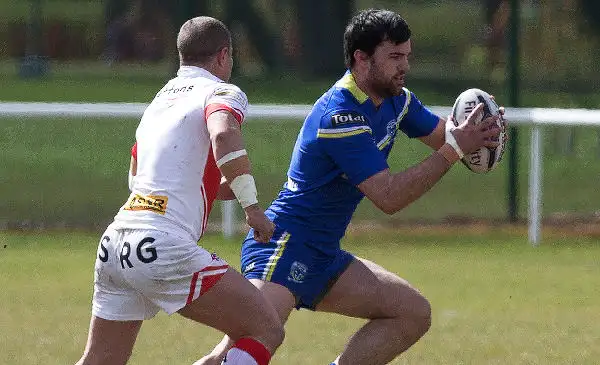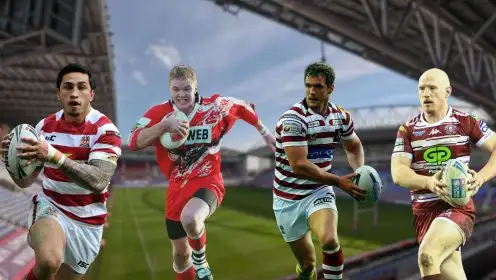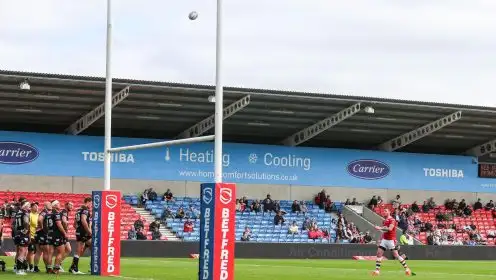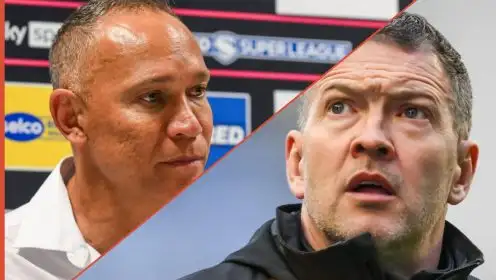The demise of rugby league’s reserve grade – what next?

Dave Thompson in action for Warrington Wolves Reserves in 2016
After Warrington Wolves and Hull FC announced that they would be scrapping their reserve teams on the eve of the season, leaving just a sprinkling of reserve sides in the game, where is there to go for Super League’s stars of tomorrow?
Young footballers have a goal; to play for Premier League clubs.
Those fortunate enough to get snapped up at a young age follow the traditional path- by working up through the clubs’ youth system.
With Rugby League, the landscape is far different. Yes, you can progress through the U16’s, U18’s and U19’s of a top Super League club- but what then?
This is a key issue concerning Super League officials- and something which has come under fire from fans, coaches and players-alike.
With no Under 21’s or 23’s to step into, are players simply being left out to dry when they reach the age of 19?
For the very elite crop of talented young up-and-comers, the pathway is far clearer; move into the first-team at the end of their teenage years.
However, not everyone can achieve this. For some, the end of youth rugby signals the end of the road for their rugby ambitions; hundreds of players with limitless potential who just never get the chance to showcase their skills.
So, the question is this- how do we ensure that young talents don’t drift out of the game, and is reserve team rugby the way forward for many of these sides?
COPYING THE AUSSIE MODEL- FROM DUBBO CYMS TO WIDNES
 Although 9442 miles separate these two countries, the model that the Australian game takes in something which English officials must surely be looking at.
Although 9442 miles separate these two countries, the model that the Australian game takes in something which English officials must surely be looking at.
It is not uncommon to see players making their debuts in Australia’s NRL competition at the age of 20 or 21.
In fact, there have been calls down under for an age limit of 19 before a player can make their first-team swansong.
Compare this to Super League’s Widnes Vikings- a team who fielded six teenagers during the 2017 campaign.
The Australian model is simple; a player is signed to a club before moving through their various age groups.
Upon reaching the Under 20’s, players either step into the first team or play for a reserve side in an equally-competitive feeder competition, with each top-flight club having a partner club.
One player who knows all about the system is Vikings centre Charly Runciman.
The 24-year old started at junior side Dubbo CYMS before moving through the ranks at St George Illawarra Dragons.
He made his move into the first team at the age of 20, and believes that players in the English game should have the same time to develop and hone their craft before being thrown in at the deep end.
 When asked whether a lack of UK reserve grade rugby was putting pressure on younger players, Runciman said: “I’d 100% agree with that. Another thing as well is the depth and the money.
When asked whether a lack of UK reserve grade rugby was putting pressure on younger players, Runciman said: “I’d 100% agree with that. Another thing as well is the depth and the money.
“The salary cap back home is around $10 million, so they have the ability to pay these guys as full-time players. Until we have the money to pay these guys to play reserve grade, it’s going to be hard.
“It’d be much better if we had a system in place for them to be able to develop in a high-level competition, competing for spots in the first team week-in, week-out. Otherwise, the people who aren’t playing in the 17 are just training.”
IS DUAL-REGISTRATION THE WAY FORWARD?
The current way players progress in the UK is often via dual-registration deals.
This involves a Super League player being sent out on loan to a partner club, quite often to gain experience in the lower leagues.
Although this idea is good in theory, it has come under scrutiny for a lack of competitiveness.
One man who has experienced life in both the first and second tier is Hull Kingston Rovers’ Chris Clarkson, who suffered relegation to the Championship in 2016.
 He believes that dual-registration can work, but only once a more competitive league framework is put in place.
He believes that dual-registration can work, but only once a more competitive league framework is put in place.
“I think that Dual Registration could be a good concept to look at, but it does mean that there would need to be a Championship league which isn’t as good as Super League, but not far off,” he said.
“If a club partners up with a Super League club and the Super League club sees someone who is playing well, then they will give them a shot at Super League.”
Absolutely agree. I find it farcical that all 12 Super League franchises and top Championship sides don’t have a Reserve Grade or Feeder side that helps strength depth and pathway progression. Australian Rugby League couldn’t function without this structure and tiers #RugbyLeague
— Daniel Watson Hayes™ (@dwatsonhayes) February 19, 2018
A strong second tier Comp that isn’t overtly tied to SL will allow greater geographical coverage and more growth of the game – the model of the QLD and NSW Cups should be replicated – Championship teams with links to SL
— Vic Collins (@VictorCollins7) February 19, 2018
He’s bang on. This should be top of the new Rfl chief’s to do list. No fans agree or want dual reg. if Keighley can run a reserve team, why can’t SL clubs? Absolute scandal
— Richard (@Rich57H) January 17, 2018
SO WHAT DOES IT ALL MEAN?
As with many issues within sport, there is no right or wrong answer.
Clubs are well within their rights to scrap their reserve teams- but at what cost?
While most plough all their money into first-team talent, only a select few see these young stars as the future of their clubs.
And maybe, just maybe, it will be those sides in a few years’ time who will be reaping the benefit of putting their faith into the stars of tomorrow.
You can follow James Messenger on Twitter @J_M_Messenger




